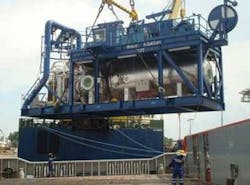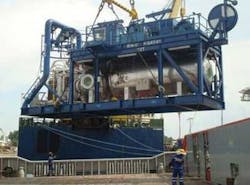SUBSEA SYSTEMS
Gene Kliewer - Houston
Nanotechnology coming to E&P
Shell Global Solution International recently held its first Nanotechnology Forum in Houston. Shell invited 30 of the individuals it identified as the top academic nanotechnologists in the world to meet with 30 of Shell’s staff to talk about how the technology might address problems in the oil and gas business.
“Nanotechnology could one day help the energy industry develop and produce more oil and gas,” says Sergio Kapusta, Shell chief scientist and manager of innovation and technology. “Nanomaterials, for example, can be much stronger than conventional materials. They can have other favorable properties, too, such as better flexibility or corrosion resistance.”
Kapusta names several areas in which nanotechnology might play a role. Those include new materials where development could result in stronger, tougher, and cheaper hardware. Nanotechnology also appears to have a role in corrosion control and flow assurance. Enhanced oil recovery also may benefit from nano-intervention. Shell sees where application of nanotechnology to reservoir surface interaction with emulsions and EOR sweeps is a prospect. Also, the characteristics of the technology may help in reservoir mapping by locating the oil/water interface more accurately and more easily.
“We could see major improvements in production” using nanotechnology, says Kapusta. “We can target the oil/water and oil/rock interfaces better with the technology.”
There are issues, still, however. For one, the nanomaterials have such an affinity for the reservoir environment that they are difficult to get deep into the horizon.
On the topic of corrosion protection, “Nano-ceramics can be flexible,” says Kapusta. This means there may be a future for “glass-lined” tubulars and seals which better resist corrosion but do not break with flexing.
“We do not know where the technology is going,” says Kapusta. “The Forum not only gave the academic scientists something to work on, but also helped create a community of researchers that understand better the oil business and its challenges.”
For reference, nanotechnology, in its broadest terms, refers to understanding and controlling matter with dimensions of 1 to 100 nanometers. A human hair is about 50,000 nm thick. At nano-sizes, materials demonstrate novel properties not found at larger sizes. These phenomena can include higher strength, greater electrical conductivity, and increased reactivity.
In addition to its dedicated nano research laboratory in Houston, Shell Technology Ventures Fund and NanoDynamics formed a joint venture called Epik Energy Solutions to pursue nano applications for practical industry application.
Riserless mud recovery tested at 1,500 m
Joint industry project partners Shell, BP, the Norwegian Research Council, and AGR Drilling Services have tested successfully a Deepwater Riserless Mud Recovery (RMR) system in 1,500 m (4,921 ft) of water using the semisubmersibleAtwood Falcon in Sabah, Malaysia, during live drilling for Sabah Shell Petroleum Co. Ltd.
The system returns drilling mud and cuttings from the seabed to the rig while drilling the top-hole prior to installing the riser. Rather than discharging mud and cuttings to the seafloor, the system collects them at the seabed and pumps them back to the drilling vessel for cleaning.
“RMR brings many technical, economic, and environmental advantages to the operator during the drilling operation,” says Lynn LeJune, project manager for the JIP.
Sat diving offshore India. Swiber Holdings Ltd., through its 70% owned Kreuz Subsea Pte. Ltd., has its first Letter of Intent to provide subsea services for $7 million on a project offshore India. As part of the project scope, Swiber will use its recently acquired saturation diving system for three months to supply dive personnel, equipment, and subsea procedures to the project.
Subsea sector faces growing pains
As the subsea oil and gas sector matures, Arthur D. Little predicts it will see consolidation as it reaches a series of hurdles to continued growth, according to the report, “Opportunities and Threats in the Maturing Subsea Market.”
The critical factors governing success in the subsea market will be shortages of skilled personnel, production equipment supply constraints, and limited access to raw materials in the next five to 10 years, the report says.
Like the rest of the upstream oil and gas business, the subsea market aims to increase production to meet growing demand against a backdrop of both skilled labor and production equipment shortages. Arthur D. Little’s report concludes that these challenges will increase in the next five years as the sector expands into new regions, equipment prices drop, and producers face increased competition from national oil companies investing in subsea facilities.
The three areas most likely to affect growth are:
- The rise of NOC power and its implications on technology development and subsea players
- The impact on current subsea service providers and the extension of subsea technology into new regions where production is growing rapidly
- Increased consolidation across the industry.

